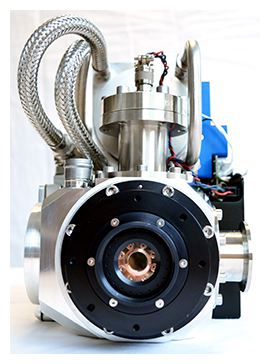Low noise infrared camera is looking at the sky
The 6-telescope beam combination instrument developed by the University of Exeter (UK) and the University of Michigan (USA), MIRC-X, together with C-RED One, the low noise infrared camera from First Light Imaging, are opening new perspectives in infrared interferometry for astronomy. The MIRC-X imager is now looking at the sky on the CHARA telescope array, which is supposedly the world’s highestresolution imaging facility in infrared light, located at the Mount Wilson Observatory in California.
The new instrument combines the light from telescopes spaced up to 330m apart. These characteristics make the CHARA array and the MIRC-X instrument suited for imaging stellar surface structures or to image the environment around stars with what is apparently unprecedented resolution.
The MIRC-X project is led by Professor Stefan Kraus (University of Exeter, UK) and Professor John Monnier (University of Michigan, USA) and funded by the European Research Council and building on earlier funding from the USA’s National Science Foundation. The ambitious goal is to image the discs around young stars for the first time with 6-telescopes infrared interferometry. These discs constitute the left-over material from the star formation process and provide the stage where planets form.
 Once planets have formed, they shape the disc environment, for instance by carving out gaps or by stirring up the disc material in warps. Spotting these structures in the inner disc regions requires an angular resolution far beyond the reach of conventional telescopes. MIRC-X and CHARA overcome this resolution barrier by combining the light from physically separated telescopes, achieving the image sharpness of a 330m telescope. These new capabilities will enable astronomers to obtain high-fidelity images of protoplanetary disc, providing a glimpse on how our own solar system might have looked like 4.6 billion years ago, during its formation phase.
Once planets have formed, they shape the disc environment, for instance by carving out gaps or by stirring up the disc material in warps. Spotting these structures in the inner disc regions requires an angular resolution far beyond the reach of conventional telescopes. MIRC-X and CHARA overcome this resolution barrier by combining the light from physically separated telescopes, achieving the image sharpness of a 330m telescope. These new capabilities will enable astronomers to obtain high-fidelity images of protoplanetary disc, providing a glimpse on how our own solar system might have looked like 4.6 billion years ago, during its formation phase.
C-RED One is a scientific commercial camera developed by First Light Imaging, dedicated to short-wave infrared (SWIR) imaging. It is based on the SAPHIRA e-APD detector from LEONARDO, allowing avalanche amplification and multiplication of electrons. C-RED One’s innovative mechanics and electronics offers 3,500 frames per second, with a read-out noise lower than 1 electron.
So far, the sensitivity of infrared interferometric instruments has been limited primarily by the read-noise of the detectors that are used for recording the faint interference pattern formed by the starlight. The C-RED One’s e-APD technology reduces these read-noise contributions by several orders of magnitudes, enabling MIRC-X to detect the faint interference pattern associated with protoplanetary discs.
C-RED One is the only commercially-available infrared camera based on the e-APD Technology. The three year development of the C-RED One has been funded by the European Commission in the frame of the Horizon 2020 SME Instrument programme.










